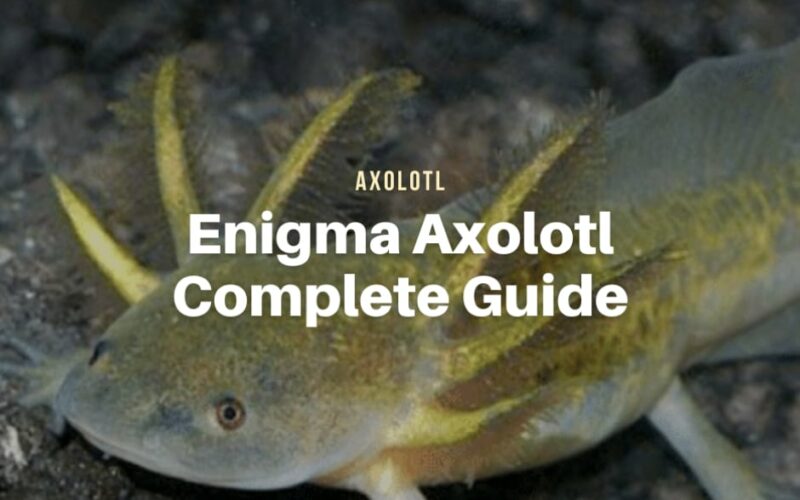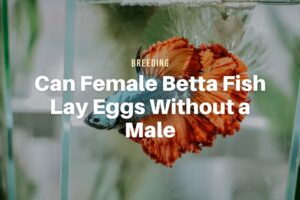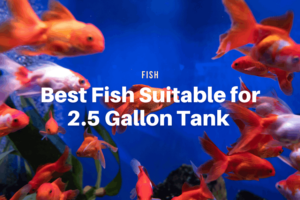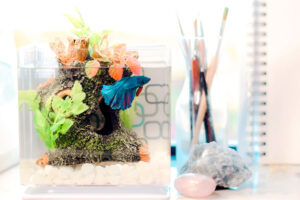There are various morphs or variants of axolotls. The enigma axolotl is among the rarest and the most beautiful. It comes in various colors, from golden yellow, gray, black, and white to pink. They are a sight to behold. Our complete guide here will help you get to know more about the variant.
Enigma Axolotl Origin
There are 15 morphs or variants of axolotls. One of them is the enigma variant. The enigma variant came out to be by pure chance. No one knows exactly how it was bred, hence the name. Since the first creation of the variant, there haven’t been many words about how other enigmas are being created.
Appearance
The enigmas’ appearance is what makes them stand out from other variants. Unlike other variants, enigmas come in dark colors and other shades. These unique salamanders have white bellies and toes, pale red gills, and golden eyes.
They also have bright golden patches all over their body. Enigmas have a lot of iridophores in their genes. These are the reason why they look greenish-gray.
Fun fact: Enigmas’ body gets darker as they grow older.
Lifespan
The lifespan of enigmas in general is 15 years. With proper diet and care, your enigma can live much longer.
How Big Can Enigma Axolotl Grow?
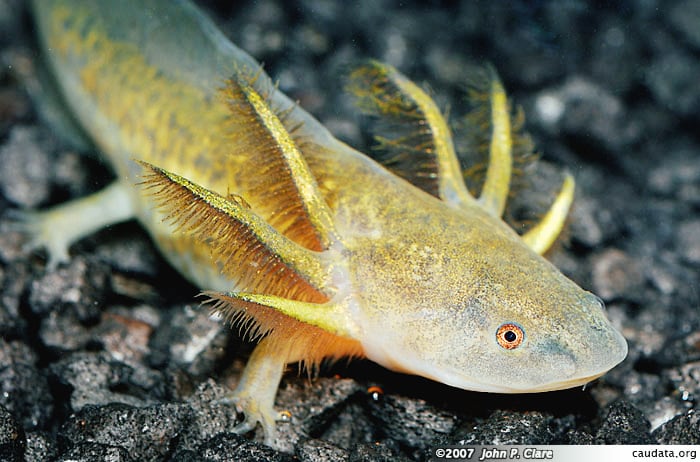
Like other axolotls, an average enigma variant can grow to 11 to 12 inches. Note that this is the average length. Whether your enigma grows to this size when it reaches adulthood depends on how well you feed and take care of it.
Aquarium Setup for Enigma Axolotl
Fish Tank
First thing first, the tank. If you want to keep an enigma, the smallest tank size is 29 gallons. This is the bare minimum. If you can get a larger tank, then it is better. A 40-gallon tank would be ideal for an enigma.
Why would you need a large tank? There are two main reasons. Axolotls grow rapidly. Thus, starting with a smaller tank and then changing to a larger one is unreasonable. You’d be better off using a larger tank from the get-go.
These rare salamanders are notorious for their heavy bio-waste as well. They produce nitrate constantly. If you keep an enigma in a smaller tank, there won’t be enough water to dilute it. As a result, the tank will get polluted quickly.
This is unlikely to be an issue with a larger tank. You will still need to do regular water changes, yes, but keeping the water parameters in the tolerated range will be easier. For starters, you must maintain the nitrate level to < 20 ppm at all times.
As for the shape of the tank, it is always better to go with a longer tank than a wider one. A longer tank with more floor space resembles their natural habitats more than a wider tank does.
Keep in mind that axolotls can jump. To keep your enigma safe, make sure that the aquarium water level is not too high. You can also use a lid to prevent your aquatic companion from hurting itself.
Aquarium Cycle
An enigma tank must be fully cycled before it is used. If you don’t have a fully cycled tank, wait until you have it. You shouldn’t wait for too long. It usually takes 4 to 12 weeks to fully cycle an aquarium.
Water Quality
An enigma tank should have 0 ppm ammonia, 0 ppm nitrite, and 5 to 20 ppm nitrate at all times. The pH of the tank should be anywhere between 6.5 and 8.0.
Water Changes
Axolotls have a heavy bio-load. You need to change the water once a week to keep the level of nitrate under 20 ppm at all times. Ammonia spikes could be an issue as well. As such, regular water changes are a must.
Water Conditioner
A water conditioner is a must-have if you keep an axolotl as a pet. You need to use the conditioner every time you add new water to the tank.
Do keep in mind that not all conditioners are suitable for axolotls. Aloe vera and iodine contents are toxic for axolotls. Avoid using a water conditioner that contains them.
Temperature
If you want to keep your enigma happy and healthy, you need to mimic their natural habitats as close as possible. In this case, keeping the water temperature cool.
If the water temperature is too high for an axolotl to handle, it will lead to stress and other health issues. On the other hand, if the temperature is too low, it will slow down the animal’s metabolism.
This is not a problem if it occurs temporarily. But if prolonged, a low temperature is unhealthy for axolotls.
Lighting
Axolotls are sensitive to light. So, keeping your enigma under low to no lighting conditions would be best.
Substrate
While a substrate can make a tank more appealing, it is not a must for an enigma tank. Axolotls ingest anything that they can suck. A tank substrate is not an exception. The problem is, the substrate might cause impaction.
If you want a substrate for the tank, you cause fine sand with a grain size of 1 millimeter. If your axolotl is 6 inches or longer, fine sand at that size shouldn’t be a problem. It will ingest the sand, but the sand will move through without causing any harm.
If your enigma is smaller, consider rocks as the substrate. Rocks are a good option for a larger enigma, too. Regardless of the size of the animal, you want rocks that are at least the same size as the animal’s head. This way, your enigma won’t be able to ingest the substrate.
Going without a substrate is also an option It makes cleaning a lot easier. Plus, there isn’t any impaction risk from a substrate, too. Don’t fancy a bare tank? Add some tiles to it to make it more appealing.
Habitat
Axolotls are shy creatures. This is something you should keep in mind when creating a habitat for your enigma. For example, create some hiding spots so your aquatic friend can hide whenever it wants.
Live aquatic plants make a good addition as well. The downside of live plants is that your options are limited. Axolotls can’t stand bright light. So if you want to add live plants, add ones that can thrive in a low-lighting environment.
In addition, you can’t use any fertilizer for the plants. Make sure to choose low-maintenance aquatic plants that require no supplementation.
Decorations
When it comes to decorations, you can be as creative as you want. One thing to keep in mind is to avoid adding sharp surfaces or objects to the tank.
Axolotls have excellent regenerative capabilities. They can heal wounds and even lost limbs. They, however, can still feel pain. You don’t want to create an environment with decorations that might hurt your enigma.
Tank Mate for Enigma Axolotl
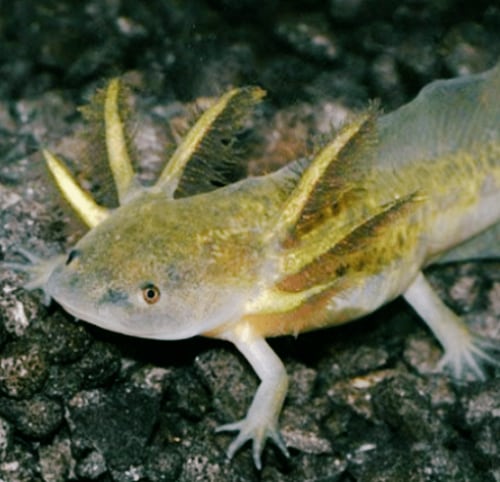
Enigmas have no problem being on their own in their tank. If anything, adding tank mates can cause more harm than benefits. The more aquatic life a tank has, the more waste you have to deal with. An enigma axolotl alone can make the tank polluted quite rapidly.
In addition, keeping an enigma and fish together can cause infections and injuries, impaction, and choking, and they may prey on each other.
That’s not to say you can’t add tank mates in an enigma tank, however. The key is to select the right tank mates and be extra cautious.
Some compatible tank mates for an enigma include
Another axolotl
While you can keep adult axolotls together, don’t put them together until both reach adulthood.
Mini snails
Mini snails tend to stay at the bottom of the tank. They live in harmony with axolotls and can help clean waste in the tank.
Guppy fish
Large guppy fish can be tank mates for adult axolotls as well.
Food & Diet
Food
Axolotls are carnivores. That is why you want to avoid feeding your enigma with vegetables. It won’t eat them. In the wild, their diet consists of small fish, freshwater insects, worms, and crustaceans. Pretty much what they can put in their mouth.
Another thing to keep in mind is that they are cannibalistic. If there is not enough food available, these rare salamanders won’t hesitate to bite another.
You can offer your enigma bloodworms, frozen brine shrimp red wigglers, or lean beef heart. Although they are not picky eaters, you want to give your enigma the best food so it can be healthy and happy.
It is exciting to watch an enigma eat. But, avoid overeating your aquatic companion. Overeating is unhealthy and can lead to various issues. Moreover, your enigma needs time to digest food.
Feeding Schedule
Feeding frequency becomes less and less frequent as the animal grows. During hatching and baby stages, an enigma should be fed 2 times per day. When it becomes a juvenile, it needs to eat only once a day.
In the sub-adult to the adult stage, an enigma needs to eat even less frequently. You should feed it every other day. Finally, when your enigma axolotl matures and reaches adulthood, you need to feed it every 2 to 3 days.
Here’s what an enigma feeding schedule looks like.
| Size | Stage of life | Feeding frequency | Recommended food type |
|---|---|---|---|
| < 1 inch | Hatchling | 2 times per day | Baby brine shrimp |
| 1.5 to 3 inches | Baby | 2 times per day | Frozen bloodworms, blackworms |
| 3 to 5 inches | Juvenile | 1 time per day | Worms, pellets, gel food |
| 6 to 8 inches | Sub-adult to adult | Every other day | Worms, pellets, gel food |
| > 8 inches | Adult | Every 2 to 3 days | Worms, pellets, gel food |
The Amount of Food
How much food should you give your enigma? There is no absolute rule to follow regarding the amount of food. Most breeders recommend feeding the animal as much food as it will eat at a time until it reaches the juvenile–adult stage.
It can be quite tricky to determine the amount of food you should give your enigma. After all, it is different from one enigma to another. Therefore, some trials and errors are required.
During a feeding session, feed your enigma until it refuses the food. When it refuses the food, remove the food from the tank at the end of the session.
When you feel your enigma hasn’t eaten as much as it should, increase the amount of food gradually. Since the increase is gradual, it allows the animal to get used to more food. Eventually, you will know the right amount of food your enigma needs.
How to Feed Enigma Axolotl
Next, how to feed. Knowing the food, feeding frequency, and amount of food is absolutely important. So is knowing how to feed an enigma.
Axolotls have poor eyesight. They rely on their sense of touch and vibrations to navigate their surroundings. Keep this in mind when feeding your enigma.
Feeding It with Worms
Worms are excellent protein sources for axolotls. You want to add them to your enigma’s diet. The downside of worms is that it can be a hassle to feed them to your aquatic companion.
Feed the animal by dropping the worms over its head and hoping it senses the worms and eats them. If you don’t want to touch the worms, use tongs to grab the worms and wiggle them around your enigma’s mouth so it can sense them. If it misses the worms, retrieve them and wiggle them again.
Feeding It with Pellets
Pellets make a nice addition to the diet, too. Not only that, but pellets also don’t come with the hassle of live or frozen foods. They are easily available, too.
Feed your enigma by dropping pellets over its head. You can use your hand or tongs, your choice. Tongs are more convenient and less messy. It’s just that they are not suitable for smaller pellets.
Using a feeding dish is an option as well. It is not as easy as using a hand or tongs. After all, you need to train your enigma to eat from the dish. But it is much less messy than using a hand or tongs. Not to mention you get to see your enigma eats from the dish, too, which is quite cute.
How to Breed Enigma Axolotls
It isn’t possible to breed enigma axolotls, at least not intentionally. The enigma variant was originally bred by pure chance. It is a unique creation. As such, it is very unlikely to be replicated. While you can breed enigmas, the offspring is unlikely to be an enigma.
How Much Does an Enigma Axolotl Cost?
Enigma axolotls are quite rare. Not surprisingly, they are very expensive. The price of an average enigma is in the $1,500 range. As a comparison, the price of a common morph is between $30 and $50. That’s just how expensive enigmas are.
Where to Buy an Enigma?
Due to their rarity, enigmas are not as available as the common morphs. With sightings of the variants numbering only a few, the chance of purchasing an enigma is very slim. If you happen to find an enigma advertised, consider yourself lucky.
The enigma axolotl is a fascinating creature. Not only it is difficult to find, but it also exhibits beauty that no other morphs do. Other than its enigmatic origin, appearance, and expensive price, the enigma morph is the same as other axolotls. It has the same tank setup, food, and diet.
